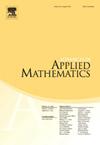Cells of fixed height in Catalan words and restricted growth functions
IF 1.3
3区 数学
Q3 MATHEMATICS, APPLIED
引用次数: 0
Abstract
A word of length n over the set of positive integers is called a Catalan word whenever and for . A restricted growth function is defined as a word of length n over the set of positive integers where and for we have . We also define cells and heights of cells and we represent such words as bargraphs (otherwise known as polyominoes) where the ith column contains cells for and where all columns have their bottom cell on the x-axis. In the case of Catalan words, we prove a relationship between the number of cells at different heights and first terms of the expanded polynomial . In the case of restricted growth functions we find polynomials where the coefficient of counts the number of cells of height j across all rgfs with n parts. In this case we also find bivariate generating functions for rgfs with k blocks, where the generating functions tracks the number of cells at a given height as well as the number of parts.
加泰罗尼亚语中的细胞高度固定,生长功能受限
当w1=1且当k=2,3,…,n时,长度为n的词w=w1w2, wn称为加泰罗尼亚词。一个受限生长函数被定义为一个长度为n的词w=w1w2,在w1=1的正整数集合上,当k≥2时,我们有1≤wk≤max (w1,w2,⋯,wk−1}+1)。我们还定义单元格和单元格的高度,并将这些词表示为条形图(也称为多线形图),其中第i列包含1≤i≤n的wi个单元格,并且所有列的底部单元格都在x轴上。在加泰罗尼亚语的情况下,我们证明了不同高度的单元数与展开多项式(1+x)2n的第一项之间的关系。在限制生长函数的情况下,我们发现多项式Fn(x),其中xj的系数计算了所有有n个部分的rgfs中高度为j的单元格的数量。在这种情况下,我们还找到了具有k块的rgfs的二元生成函数,其中生成函数跟踪给定高度的单元格数量以及部件数量。
本文章由计算机程序翻译,如有差异,请以英文原文为准。
求助全文
约1分钟内获得全文
求助全文
来源期刊

Advances in Applied Mathematics
数学-应用数学
CiteScore
2.00
自引率
9.10%
发文量
88
审稿时长
85 days
期刊介绍:
Interdisciplinary in its coverage, Advances in Applied Mathematics is dedicated to the publication of original and survey articles on rigorous methods and results in applied mathematics. The journal features articles on discrete mathematics, discrete probability theory, theoretical statistics, mathematical biology and bioinformatics, applied commutative algebra and algebraic geometry, convexity theory, experimental mathematics, theoretical computer science, and other areas.
Emphasizing papers that represent a substantial mathematical advance in their field, the journal is an excellent source of current information for mathematicians, computer scientists, applied mathematicians, physicists, statisticians, and biologists. Over the past ten years, Advances in Applied Mathematics has published research papers written by many of the foremost mathematicians of our time.
 求助内容:
求助内容: 应助结果提醒方式:
应助结果提醒方式:


